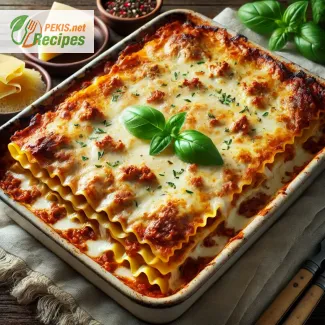
Italian Lasagna with Meat Ragù is the epitome of comfort food, embodying centuries of Italian culinary tradition. This iconic dish combines the richness of slow-cooked meat ragù, velvety béchamel sauce, layers of handmade pasta, and a melty, golden cheese topping, creating a taste experience that feels like a warm embrace with every bite. Italian lasagna is much more than just pasta and meat—it's a symbol of family gatherings, long-awaited dinners, and the Italian commitment to flavor and quality in every layer.
A Journey Through Layers of Flavor
Each layer of Italian lasagna is thoughtfully prepared to ensure that every forkful is a balanced, harmonious blend of flavors. The base of this culinary masterpiece is its ragù sauce, which is typically crafted from a blend of ground beef and pork or occasionally veal. Cooked to perfection over low heat, the meat melds with a mixture of finely diced carrots, onions, and celery, creating a soffritto that forms the flavor foundation. Tomatoes are added next, often in the form of crushed San Marzano tomatoes, adding the deep, rich, and slightly tangy element characteristic of an authentic Italian meat ragù.
This ragù simmers for several hours, allowing all the flavors to fully marry and develop, while the sauce thickens into a concentrated, aromatic base that permeates each bite of the lasagna. Traditional Italian kitchens often let the ragù simmer for up to four hours, enhancing the flavors and transforming simple ingredients into a deeply flavorful sauce.
A Silky Béchamel for Creamy Perfection
In addition to the ragù, Italian lasagna wouldn't be complete without béchamel sauce, a French-inspired yet Italian-beloved sauce known for its smooth, creamy texture. This delicate, creamy layer serves as a contrast to the hearty meat ragù, enriching the lasagna with a luscious mouthfeel. Made with a simple combination of butter, flour, and milk, béchamel is whisked to create a thick, creamy sauce that spreads easily over each pasta layer. A dash of nutmeg and a pinch of salt add subtle complexity to the béchamel, balancing the richness and adding depth without overpowering the dish.
The Heart of Lasagna: Handmade Pasta Layers
For the authentic Italian experience, fresh pasta sheets are essential, offering a delicate bite that complements the hearty filling. Traditionally, pasta sheets are prepared with a mixture of flour and eggs, kneaded to the ideal elasticity, then rolled out into thin sheets. The handmade pasta absorbs the sauces while maintaining a tender, slightly al dente texture even after baking. In the Italian kitchen, each pasta layer is an opportunity to embrace tradition, infusing the lasagna with a home-crafted authenticity.
Golden Layers of Cheese
Italian lasagna is crowned with a blend of cheeses, often a mix of Parmesan and mozzarella, providing the signature golden-brown, bubbling crust. Parmesan cheese adds a sharp, nutty flavor, enhancing the richness of the ragù, while mozzarella melts into a gooey, luxurious topping that stretches delightfully with each serving. This cheese topping is more than just a finishing touch—it’s the culmination of hours of cooking, adding visual appeal, texture, and a delightful tang to the final product.
Preparation and Storage Tips
One of the beauties of traditional Italian lasagna is its make-ahead potential. In fact, making the lasagna a day or two in advance not only saves time but allows the flavors to deepen and meld together, producing an even more flavorful result. You can assemble the lasagna up to 48 hours before baking, covering it tightly with plastic wrap and refrigerating it until ready to cook. This makes lasagna an excellent choice for special occasions and gatherings, where preparing in advance can ease the day-of cooking demands.
Once baked, lasagna can be served immediately or allowed to rest for about 15-20 minutes before slicing. This resting period is crucial as it allows the layers to set, making it easier to cut clean slices that hold together beautifully. Leftovers can be refrigerated in an airtight container and will stay fresh for up to four days. To reheat, simply cover with aluminum foil and bake at a low temperature to keep it moist, or use a microwave if you prefer a quicker option.
For longer storage, lasagna can also be frozen. To freeze, it’s best to assemble the lasagna but avoid baking it, as this preserves the texture of the pasta and sauce. Wrap it well and freeze for up to three months. When you’re ready to bake, simply thaw the lasagna in the refrigerator overnight, then bake it according to the recipe instructions, adding a few extra minutes if needed to ensure it’s heated through.
A Timeless Dish for Every Occasion
Italian lasagna with meat ragù is perfect for large gatherings and family dinners, embodying the joy of sharing food with loved ones. Each layer represents the dedication and craftsmanship that goes into Italian cuisine, creating a dish that feels like both an indulgence and a tradition. This iconic lasagna holds a cherished place in Italian food culture and, whether freshly baked or made ahead, is sure to impress and satisfy with its heartwarming flavors and authentic Italian essence.
- Prepare the Meat Ragù
- In a large, deep saucepan, heat the olive oil over medium heat.
- Add the onion, carrot, and celery. Sauté for about 8-10 minutes until softened and fragrant.
- Increase the heat slightly and add the ground beef and pork. Cook for another 10 minutes, stirring occasionally, until the meat is browned.
- Stir in the white wine and cook until it mostly evaporates, about 5 minutes.
- Add the tomato purée, tomato paste, and beef stock. Season with salt, pepper, bay leaves, and thyme.
- Reduce the heat to low and let the sauce simmer gently for about 1.5 hours, stirring occasionally. The ragù should thicken and deepen in flavor.
- Prepare the Béchamel Sauce
- In a medium saucepan, melt the butter over low heat.
- Add the flour and whisk continuously for 2-3 minutes to create a smooth roux without browning.
- Gradually pour in the milk while whisking constantly to avoid lumps.
- Continue cooking and whisking until the sauce thickens to a creamy consistency (around 10 minutes).
- Season with salt and a dash of nutmeg. Remove from heat and set aside.
- Assemble the Lasagna
- Preheat the oven to 180°C (350°F).
- Grease a rectangular baking dish (approximately 25 x 35 cm or 10 x 14 inches).
- Spread a thin layer of béchamel sauce at the bottom of the dish, followed by a layer of pasta sheets.
- Add a layer of meat ragù on top of the pasta, followed by a generous spoonful of béchamel. Sprinkle a bit of Parmesan cheese over this.
- Repeat the layering process: pasta, meat ragù, béchamel, and Parmesan, until you’ve used all the ingredients, finishing with a final layer of béchamel on top.
- Add the mozzarella cheese slices or grated mozzarella as the final topping for a golden crust.
- Bake the Lasagna
- Cover the dish with aluminum foil and bake for 25 minutes.
- Remove the foil and bake for an additional 20-25 minutes or until the top is golden and bubbling.
- Allow the lasagna to rest for at least 15 minutes before serving. This helps the layers set and makes it easier to cut clean slices.
Storage and Make-Ahead Tips
- Make-Ahead: You can assemble the lasagna up to 48 hours in advance and refrigerate it, covered, until baking.
- Storage: Leftover lasagna can be stored in an airtight container in the refrigerator for up to 4 days. For longer storage, freeze it for up to 3 months. When ready to serve, thaw in the refrigerator overnight and reheat in the oven at 160°C (320°F) until heated through.
- Reheating: For the best texture, cover with foil and bake at a low temperature.
Italian lasagna with meat ragù is not only a delicious, traditional Italian dish but also a complex, nutrient-dense meal that provides a well-rounded profile of essential vitamins, minerals, macronutrients, and a satisfying energy boost. While indulgent, this dish also offers nutritional benefits, as well as some considerations for balance and moderation in a healthy diet.
Impact of Nutrients and Ingredients on Health
The meat ragù provides a hearty source of protein, critical for muscle repair, immune health, and satiety. The beef and pork in the ragù are rich in B vitamins, particularly B12, B6, and niacin (B3), which are essential for energy production, red blood cell formation, and overall cellular health. Vitamin B12, found exclusively in animal products, is vital for nervous system function, and its deficiency can lead to fatigue and neurological issues.
Additionally, beef and pork contain zinc and iron, both of which play key roles in immune function, cognitive performance, and the formation of hemoglobin. Iron is especially important in supporting oxygen transport throughout the body, and the presence of vitamin C in the tomatoes aids in iron absorption. Zinc contributes to immune support, skin health, and wound healing, making these components of lasagna particularly beneficial in a balanced diet.
The tomato-based sauce is a rich source of vitamin C, vitamin K, potassium, and lycopene. Vitamin C is a powerful antioxidant that boosts immune health, skin integrity, and collagen formation. Vitamin K is important for blood clotting and bone health, while potassium helps regulate fluid balance, nerve signals, and muscle contractions. Lycopene, a potent antioxidant found in tomatoes, may protect cells from damage and has been linked to a reduced risk of certain chronic diseases, including heart disease and some cancers.
The béchamel sauce, made from milk and butter, provides calcium, which is crucial for bone health, muscle function, and nerve transmission. Although butter is high in saturated fats, which should be consumed in moderation, small amounts can be part of a balanced diet and can provide fat-soluble vitamins like vitamin A, beneficial for eye health, skin health, and immune function.
Fresh pasta sheets deliver a source of carbohydrates, the body's primary energy source, necessary for physical and cognitive activities. Pasta also contains some fiber if made with whole grains, which aids digestion, regulates blood sugar levels, and promotes satiety. Additionally, pasta can be a source of folate (B9), an essential vitamin that supports DNA synthesis, cell growth, and may prevent neural tube defects during pregnancy.
The cheese in lasagna, especially Parmesan and mozzarella, is rich in calcium, phosphorus, and vitamin B2 (riboflavin). Calcium supports skeletal strength and muscle contractions, while phosphorus is involved in forming strong bones and teeth, energy production, and maintaining pH balance. Riboflavin aids in energy production, red blood cell formation, and the conversion of food into fuel. These cheeses also provide small amounts of vitamin D, which enhances calcium absorption and supports immune health.
Frequency of Consumption
While Italian lasagna with meat ragù is nutritionally beneficial in moderation, it is also high in calories, fats (especially saturated fat), and sodium. Due to its rich ingredients, consuming this dish once a week or on special occasions is recommended, particularly if maintaining a balanced diet and controlling saturated fat intake is a priority.
For those with higher caloric or protein needs, such as athletes, or those engaged in physically demanding activities, lasagna could be a suitable, hearty meal. However, for individuals with sedentary lifestyles or those managing cholesterol or weight, it’s best enjoyed as an occasional indulgence.
General Health Advice for This Recipe
- Balance with Fresh Vegetables: To create a more balanced meal, consider pairing lasagna with a side of fresh salad greens like spinach, arugula, or a mixed vegetable salad. These greens provide fiber, vitamin K, folate, and antioxidants that complement lasagna's nutrient profile and aid in digestion.
- Modify for Healthier Options: Small adjustments can improve the lasagna's health impact. For instance, reduce the amount of cheese or use a part-skim mozzarella to lower the saturated fat content. Alternatively, try a light béchamel sauce by using low-fat milk and less butter to cut down on calories.
- Whole Grain Pasta Sheets: If available, use whole grain or whole wheat lasagna sheets to increase the dish's fiber and B vitamin content. This adds a nutritional boost and helps improve satiety, which may help with portion control.
- Adjust Sodium Content: Lasagna can be high in sodium, particularly from cheese and salt used in cooking. Limit additional salt, use low-sodium beef stock, and consider reducing the Parmesan in the top layer. Using herbs and spices like basil, oregano, and thyme can add flavor without extra salt.
- Substitute for Dietary Needs: If someone in your household is lactose intolerant or allergic to dairy, opt for dairy-free butter and plant-based milk alternatives for the béchamel sauce. Dairy-free cheeses can also be used for the topping, allowing everyone to enjoy this classic without compromising on flavor.
Italian lasagna with meat ragù embodies rich flavors and a diverse nutritional profile that combines protein, vitamins, minerals, and essential fats. Though high in calories and fats, it remains a nutritionally valuable dish when enjoyed responsibly. By pairing with fresh, leafy vegetables and using alternative ingredients as needed, this classic lasagna can be made part of a well-rounded diet.
- Dairy: Present in Parmesan, mozzarella, milk, and butter.
- Gluten: Present in flour (béchamel sauce) and pasta.
Substitution Tips for Allergens:
- Dairy-Free: Substitute butter with dairy-free margarine and replace milk with a non-dairy alternative like almond or oat milk. Use dairy-free mozzarella and Parmesan.
- Gluten-Free: Use gluten-free lasagna sheets and substitute the all-purpose flour in the béchamel sauce with a gluten-free flour blend or cornstarch.





